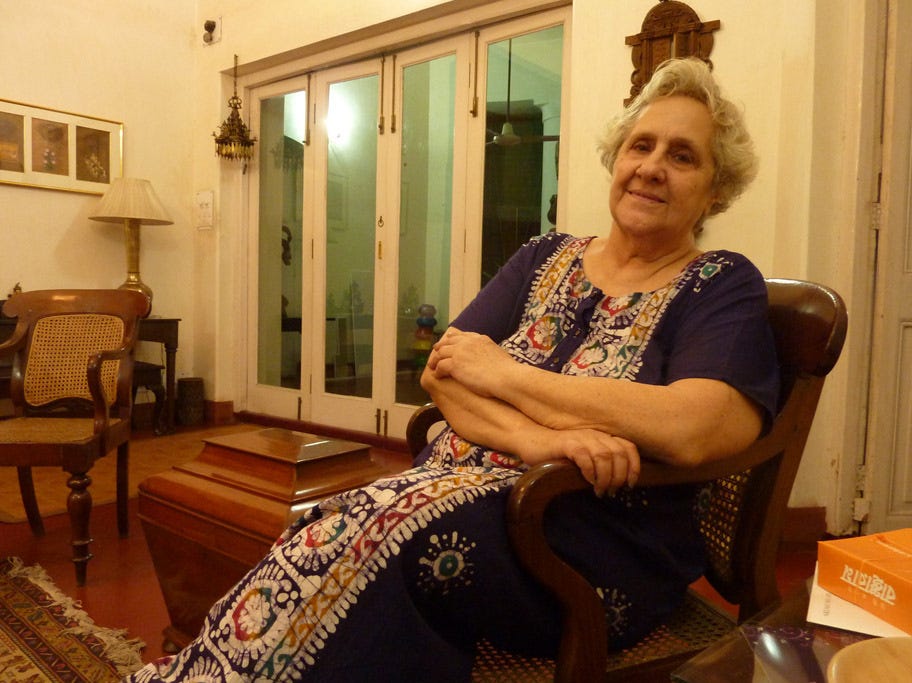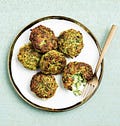I make these Chicken, Scallion, and Ginger Fritters on repeat all summer long. They are everything you want (but so rarely get) in a chicken patty: light, juicy, and packed with flavor. They also have a fascinating Jewish history. Get the recipe and story by subscribing to The Jewish Table - thank you for your support!
Several years ago, when I was researching dishes to include in my most recent book, The Jewish Cookbook, I learned about (and immediately reached out to!) an 80-something year old woman named Flower Silliman. Silliman grew up in Kolkata, India, as part of a small but thriving community of Jews who had relocated from Iraq and Syria in the late 18th century.
Kolkata’s Jewish community, which at its peak included about 6,000 people, is all but extinct. (The majority of Indian Jews immigrated to Israel in the mid-20th century.) But about a decade ago, after years of living abroad herself, Silliman decided to move back to her childhood home.

My phone call with Silliman was the kind of “pinch me, am I dreaming?” experience that makes my work as a Jewish food researcher and writer so energizing. I felt her warmth and charm, despite the iffy international phone connection. And I marveled at the memories she shared - about growing up as a Baghdadi Jew (as they were commonly called) in Kolkata, and the network of synagogues and schools, kosher butchers and bakeries, Shabbat dinners and holiday meals that defined her childhood.
Jewish Cuisine in Kolkata
As an accomplished home cook and former restaurant owner (for years, she ran a kosher Indian eatery in Jerusalem called Maharaja), Silliman understands the connection between food, culture, and identity. She talked at length about the cuisine of the Baghdadi Jews, which combines the Middle Eastern dishes they brought with them from Syria and Iraq, and the Indian ingredients and flavors - things like ginger and turmeric - they found in their new home. As Copeland Marks wrote in his 1986 cookbook, The Varied Kitchens of India, in home’s like Silliman’s, “There was a culinary marriage between the cooking of Baghdad and that of Calcutta.”
Silliman told me about mahashas, or meat and rice-stuffed vegetables simmered in a tamarind-ginger sauce, and bamia khatta, a dish of stewed chicken with okra. She shared her love for the fenugreek-based chutney called hulba, and aloo makala, crispy fried potatoes with a cross-cultural name. (Aloo is the Hindi word for potatoes and makala is derived from the Arabic word for fried.)
Then she mentioned arook tahine - feather-light fried patties made from chicken or fish, and flavored with heaps of ginger, scallions, and cilantro. (You can sub parsley if you’re a cilantro hater!) I wanted to make everything she described, but the chicken fritters in particular stood out.
A “Small World” Moment
During our call, Silliman said that she was the author of several self-published cookbooks. Her most recent book, 3 Cups of Flower, she said, contained a chapter dedicated to Jewish recipes from India and beyond. Despite being separated by nearly 8,000 miles, I knew I needed to get my hands on a copy of that culinary research goldmine.
I asked Silliman if she knew of any museums or shops that might have the book in stock. (To heck with shipping costs, I thought - I’m going to track it down!) She thought for a moment and then said, “Where did you say you live?” “New York,” I answered. “Well, my daughter Michal lives near Coney Island, and I’m sure she has an extra copy.”
Within minutes of hanging up with Flower, I emailed Michal. And a few days later, I drove a little less than 7 miles to pick up a copy of 3 Cups of Flower for long term loan. What a gift.
In her cookbook, Silliman writes that arook tahine are “eaten freshly fried as an appetizer or with pre-dinner drinks.” In my home, I typically serve them with a big green salad and coconut rice, and tuck the flavor-packed leftovers into pita or bread for a top notch sandwich. Let me know how you serve them!
Keep reading with a 7-day free trial
Subscribe to The Jewish Table to keep reading this post and get 7 days of free access to the full post archives.



